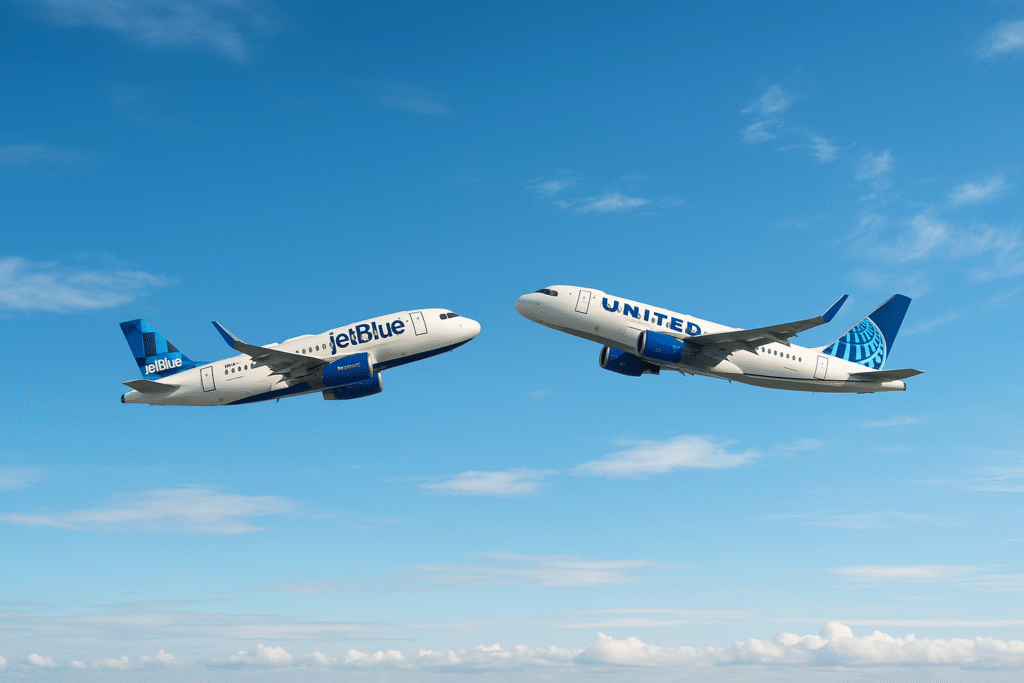The U.S. aviation world is buzzing with excitement and for good reason. The recently announced JetBlue United Blue Sky partnership marks a pivotal shift in how Americans experience cross-country travel. This strategic move between two major carriers JetBlue Airways and United Airlines—is more than just news; it’s a major leap forward in what many are calling the most significant domestic airline partnership of 2025.
Under the new Blue Sky program JetBlue United launched, travelers will now enjoy seamless interline booking, smoother coast-to-coast connections, and hassle-free baggage transfers—all on a single itinerary. Whether you’re a frequent business flyer hopping between tech hubs or a casual traveler planning a vacation across states, the JetBlue and United Airlines partnership promises fewer travel headaches and more flight flexibility.
In this article, we’ll explore what the JetBlue United Blue Sky partnership really means for passengers, how it reshapes the competitive landscape, and why this domestic airline partnership in 2025 is getting so much attention from travelers and industry experts alike.
Table of Contents
What Is the JetBlue United Blue Sky Partnership?
The JetBlue United Blue Sky partnership is not a merger and it’s not a full-blown codeshare either. Instead, it’s a strategic move in the world of domestic aviation, formally known as an interline agreement. This collaboration between JetBlue and United Airlines gives passengers the ability to book a single ticket that combines flights from both carriers, check luggage all the way to their final destination, and enjoy access to a much broader U.S. flight network.
This JetBlue and United Airlines partnership is being rolled out under the new Blue Sky program—an initiative designed to simplify travel across the country and make connecting routes more efficient for everyday flyers.
Interline 101: Simplified
So what exactly is an interline agreement? Think of it as a handshake behind the scenes. While JetBlue and United remain independent airlines, this agreement allows them to coordinate flights on a single itinerary. That includes seamless baggage transfers, simplified rebooking if a flight is delayed, and more flexibility when combining legs from both carriers.
In practice, it means you could fly JetBlue from Boston to Chicago, then switch to United from Chicago to San Diego all under one booking reference, without needing to re-check your bags or scramble between terminals. For the everyday traveler, the JetBlue United Blue Sky partnership is designed to reduce friction and boost convenience.
Why It’s a Game-Changer for Coast-to-Coast Travelers
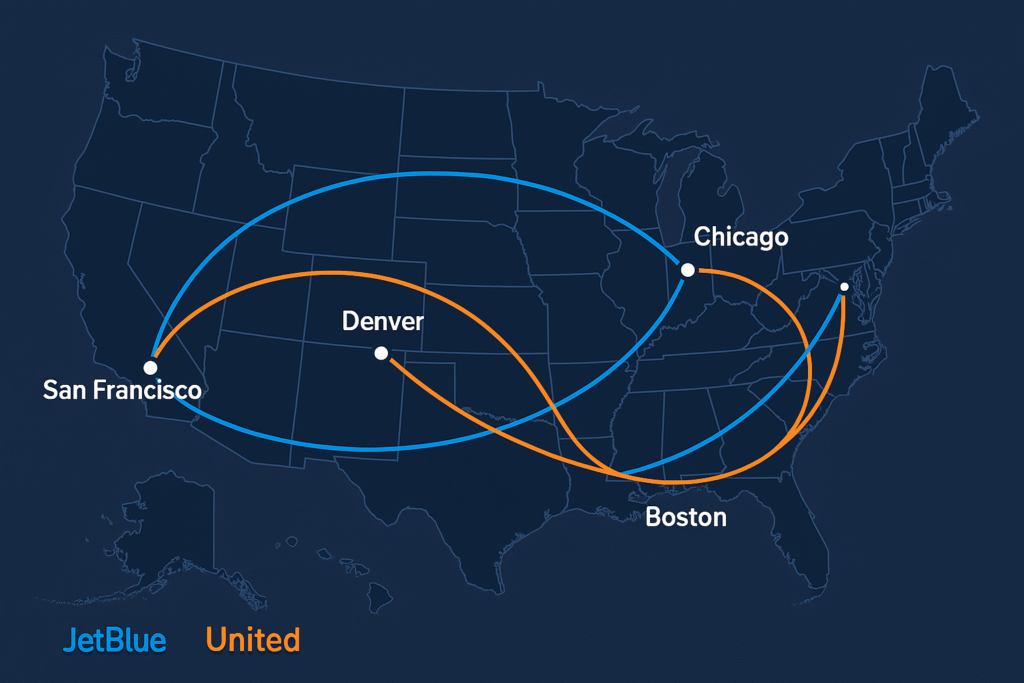
This domestic airline partnership in 2025 couldn’t have come at a better time. U.S. travelers are increasingly looking for smoother options for flying from coast to coast, and this agreement is built specifically with that goal in mind.
JetBlue is well-established in key East Coast hubs like New York JFK, Boston Logan, and Fort Lauderdale. Meanwhile, United has a dominant presence in the Midwest and West Coast, with strong operations in Chicago O’Hare, Denver, San Francisco, and Los Angeles. By linking their networks under the Blue Sky program JetBlue United, the two airlines are unlocking far more route combinations for passengers across the country.
Here’s how this plays out in real life:
Sample Route Benefits:
- Boston → Chicago (JetBlue) + Chicago → Seattle (United)
- Newark → Denver (United) + Denver → Long Beach (JetBlue)
- JFK → San Francisco direct (JetBlue or United) with added rebooking flexibility
This partnership offers more than just added cities—it’s about making cross-country flights less stressful. Travelers can now avoid long layovers, eliminate the need for separate bookings, and enjoy smoother transitions through airports.
And for those flying into smaller regional airports, the JetBlue United Blue Sky partnership expands access by combining both carriers’ networks—without the cost or complication of a larger alliance or merger.
Why This Domestic Airline Partnership in 2025 Matters
In a post-pandemic world, travelers value convenience more than ever. The JetBlue and United Airlines partnership under the Blue Sky program is a timely response to changing expectations. People want fewer touchpoints, less waiting, and more predictability.
By aligning strategically without merging, JetBlue and United have found a way to offer a better passenger experience while maintaining their brand identities. For travelers, this means smarter options when booking coast-to-coast trips, whether for business or leisure.
This is especially important in 2025, as domestic travel demand rises and passengers seek out airlines that offer value, comfort, and flexibility.
The JetBlue United Blue Sky partnership may not be a merger, but it represents the future of domestic airline collaboration: less friction, more options, and a stronger focus on what passengers really want.
Top Benefits for Passengers
The JetBlue United Blue Sky partnership is built around one core promise: make domestic travel smoother, smarter, and less stressful. This new JetBlue and United Airlines partnership is all about delivering real convenience to travelers—whether you’re flying for business, family, or adventure.
Here are the key passenger benefits of the Blue Sky program JetBlue United recently introduced:
One Booking, One Check-In
With the Blue Sky interline agreement in place, you can now book a single itinerary that includes flights operated by both JetBlue and United Airlines. That means one ticket, one confirmation number, and a unified check-in process.
This is a huge win for passengers who previously had to juggle multiple airline tickets when flying coast to coast. Whether you’re booking directly through JetBlue, United, or a trusted OTA like Google Flights, the experience is now simplified.
🡒 Learn more about how interline agreements work from IATA’s guide.
Baggage Transfers Across Airlines
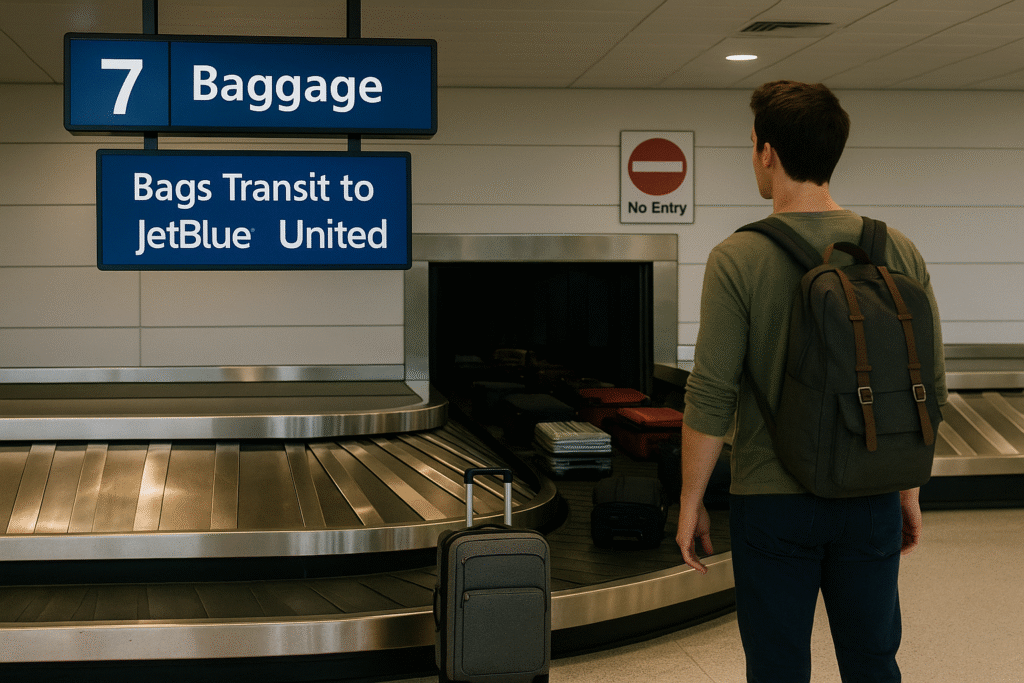
Thanks to this domestic airline partnership in 2025, you no longer need to claim your bags between legs of your journey. If your itinerary includes both JetBlue and United flights, your checked luggage will be automatically transferred to your final destination.
For frequent travelers, this eliminates one of the most common pain points in multi-airline bookings—saving time, energy, and the risk of lost baggage during connections.
🡒 See official JetBlue baggage policies here and United’s policies here.
Faster and Smarter Rebooking Options
Flight delays and missed connections happen—but now you’re covered across both airlines. Under the JetBlue United Blue Sky partnership, if a delay affects your journey, the partner airline can step in to rebook you without the hassle of separate cancellation policies or new tickets.
This is especially important during peak travel seasons or weather disruptions, offering more flexibility and peace of mind to passengers flying long distances.
🡒 United and JetBlue both offer mobile apps for managing rebooking options—download the United app here and the JetBlue app here.
Expanded Route Options Across the U.S.
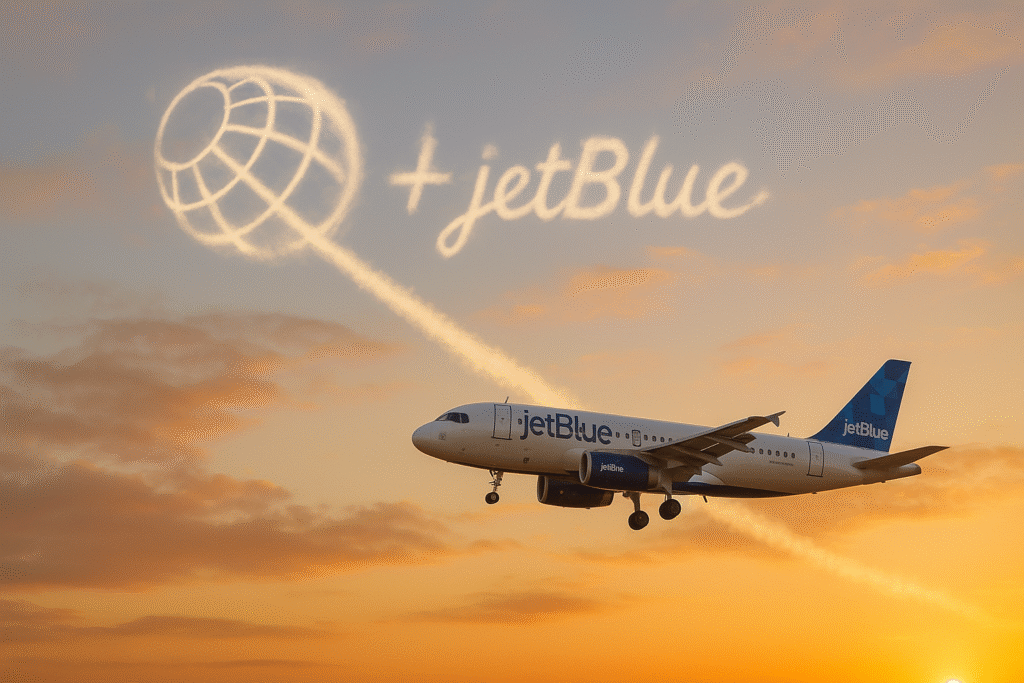
The combined networks of JetBlue and United mean more domestic destinations and better scheduling flexibility. This is particularly beneficial for travelers flying between non-hub cities, where direct flights are limited.
The Blue Sky program JetBlue United has rolled out now allows passengers to connect through major hubs like Chicago, JFK, Boston, and Denver—unlocking smarter coast-to-coast connections and minimizing layover times.
🡒 Check the updated route maps for JetBlue and for United.
What About Loyalty Programs?
One of the most common questions travelers ask about the JetBlue United Blue Sky partnership is how it affects frequent flyer benefits. If you’re already enrolled in JetBlue’s TrueBlue or United’s MileagePlus program, you’re probably wondering: Will your loyalty finally pay off across both airlines?
Here’s where things stand.
At this stage of the Blue Sky program JetBlue United has launched, the two loyalty programs—TrueBlue and MileagePlus—are still operating separately. That means any miles or points you earn on a JetBlue flight stay in TrueBlue, and points from United flights go into MileagePlus. Currently, you cannot transfer points between the two or use one account to redeem rewards on the other airline.
However, the JetBlue and United Airlines partnership is setting the groundwork for much more. Industry insiders suggest that future enhancements may include shared earning rates, reciprocal elite benefits, or even merged reward tiers for frequent flyers. In fact, many believe the Domestic airline partnership 2025 movement could usher in a new era of flexible loyalty programs across carriers.
So what should you do now? If you frequently fly on both JetBlue and United, it’s smart to stay enrolled in both programs and keep earning miles based on the airline operating each leg of your trip. And if the JetBlue United Blue Sky partnership continues to gain momentum, don’t be surprised if a more unified loyalty experience rolls out in future phases.
Industry Reactions and What It Signals
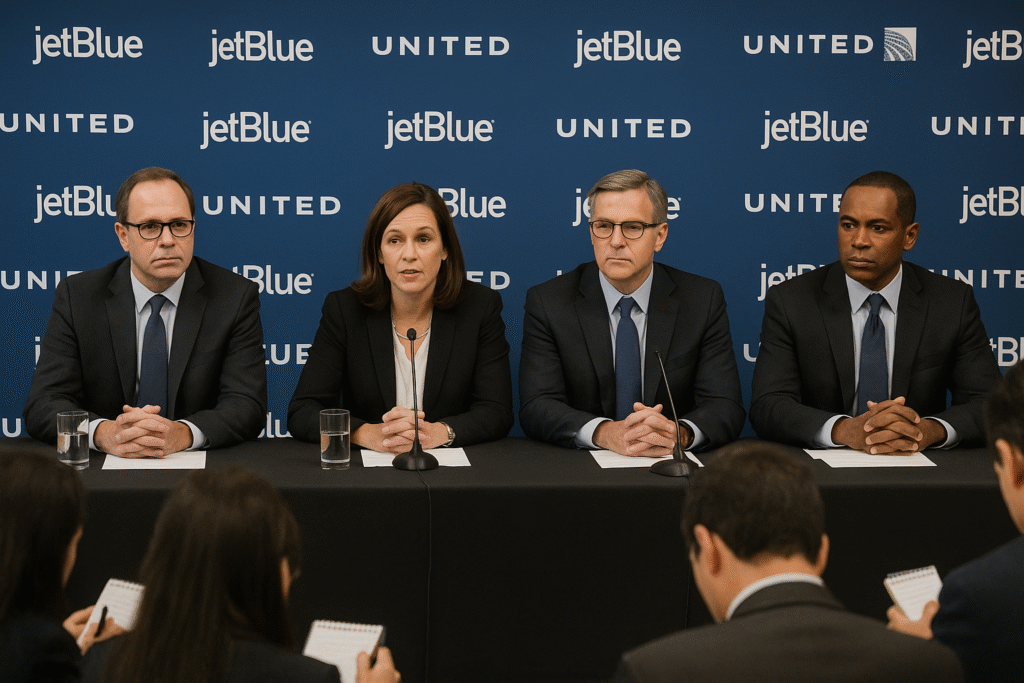
The launch of the JetBlue United Blue Sky partnership has sparked strong reactions across the travel and aviation industry. According to leading aviation analysts, this may be one of the boldest and most practical domestic airline partnerships in recent memory. Unlike past collaborations that often led to complicated mergers or antitrust challenges, this alliance focuses on smart integration without fully combining operations.
This strategic move reflects a growing trend of cooperation among major U.S. carriers—designed to improve route efficiency, reduce operational overhead, and ultimately deliver a better passenger experience. It’s the kind of alliance that airline insiders have been predicting, especially in today’s post-COVID recovery climate.
Executives from both JetBlue and United Airlines have expressed confidence in the Blue Sky program. In a recent joint statement, both airlines noted that the agreement “represents the next evolution of coast-to-coast connectivity, combining our strengths for a smarter travel experience.”
Unlike the now-dissolved JetBlue-American Airlines Northeast Alliance, which was shut down under antitrust scrutiny, the JetBlue and United Airlines partnership feels more balanced and future-proof. It’s more about complementing each other’s networks than competing in the same regions.
What the Blue Sky Program Means for U.S. Domestic Travel
The Blue Sky program JetBlue United is launching isn’t just a smart move for these two airlines—it could signal broader change across the domestic travel landscape.
With rising fuel prices, pilot shortages, and increasing demand for better connections, airlines are being pushed to innovate. Flexible, interline partnerships like this one offer a middle path—giving travelers more convenience without the complications of full-on mergers or airline acquisitions.
Here’s how this Domestic airline partnership in 2025 could reshape the U.S. travel experience:
- More flexibility during weather delays, high-traffic holidays, or flight disruptions.
- New coast-to-coast travel corridors that include secondary and underserved cities.
- Competitive pressure on other carriers such as Delta, American, and Alaska Airlines to form similar partnerships or revisit their interline strategies.
If the JetBlue United Blue Sky partnership proves successful, it could set a precedent for other U.S. carriers. This kind of alliance offers the benefits of scale without eliminating brand identity—and passengers stand to gain the most.
Key Takeaways: Should You Book with JetBlue or United’s Blue Sky?
If you’re flying across the U.S., especially from the East Coast to the West Coast, now’s a great time to explore the new options created by this JetBlue and United Airlines partnership.
The JetBlue United Blue Sky partnership is ideal for:
- Business travelers who need tight schedules and reliable rebooking options.
- Vacationers flying to smaller or secondary cities that require connecting flights.
- Frequent flyers who value smoother baggage transfers and less booking hassle.
As travel booking platforms begin to integrate the Blue Sky program JetBlue United routes, expect to see more combined itineraries with simplified check-ins, faster baggage transfers, and a unified booking reference number.
Pro Travel Tips
To make the most of this domestic airline partnership in 2025:
- Book your ticket through JetBlue or United’s official website for the clearest route options.
- Allow a minimum of 90 minutes for layovers while the new interline operations are still being fine-tuned.
- Sign up for both the JetBlue TrueBlue and United MileagePlus loyalty programs—future reward integration is likely on the horizon.
- Double-check baggage fee policies. While bags will be transferred automatically, fees may depend on which airline operates the first leg of your trip.
What is the JetBlue United Blue Sky partnership?
The JetBlue United Blue Sky partnership is an interline agreement between JetBlue Airways and United Airlines. It allows travelers to book a single ticket across both airlines, check bags once, and enjoy smoother coast-to-coast connections across the U.S.
Can I check my baggage once when flying JetBlue and United together?
Yes, if your flight is booked under the Blue Sky program, your baggage will automatically be transferred between JetBlue and United flights. No need to re-check your luggage mid-journey.
Does the JetBlue United partnership include all routes?
Not all routes are included, but the Blue Sky program covers many major U.S. cities. You’ll find the most benefit on cross-country trips like Boston to San Diego or Newark to Seattle using a mix of JetBlue and United segments.
Can I earn or redeem frequent flyer miles with both JetBlue and United?
Currently, JetBlue TrueBlue and United MileagePlus remain separate. You’ll earn miles only with the airline operating your flight. Mile redemption and loyalty perks are not shared—yet.
Where can I book flights under the Blue Sky program?
You can book Blue Sky interline flights directly on JetBlue’s or United’s website. Some third-party platforms like Google Flights or Expedia may also show eligible combinations.
Final Thoughts: The Power of Partnership in the Skies

The JetBlue United Blue Sky partnership is more than just another airline alliance — it’s a forward-thinking blueprint for smarter domestic airline travel in 2025 and beyond. By combining the strengths of both carriers through the Blue Sky program JetBlue United, travelers can now enjoy seamless ticketing, smoother coast-to-coast flight connections, and fewer booking headaches.
For U.S. flyers who prioritize convenience without compromising on choices, this JetBlue and United Airlines partnership is a game-changer. Whether you’re traveling for business or heading out on a weekend getaway, this collaboration enhances the flying experience on both coasts.
As airlines continue to respond to evolving travel patterns and increasing demand, initiatives like Blue Sky prove that collaboration can be the key to staying competitive—while also delivering a better, more unified experience for passengers.
So the next time you’re jetting from Boston to San Diego, or Newark to Seattle, don’t be surprised if your flight falls under the bright banner of Blue Sky — a name that’s fast becoming synonymous with smarter, better-connected air travel.
If you’re already planning your next adventure, check out these unique cultural travel ideas that align perfectly with the spirit of exploration:
- Art Colony Weekend in Taos, NM
- Vinyl Browsing & Gallery Hops in Asheville, NC
- Pop-Up Art Galleries in Chattanooga, TN
These experiences celebrate creativity, local culture, and the kind of authentic travel moments that the Domestic airline partnership 2025 trend makes more accessible than ever before.
